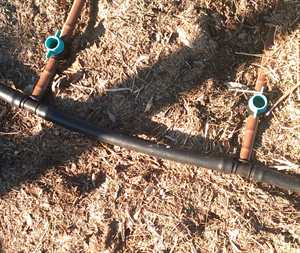
Experiments
The easiest way to do your watering is to set up a garden watering system on a timer. I know, sounds like hard work, but this is the easy way to water the garden so that it happens automatically without you doing a thing or having to go out when you come home from work and battle the mosquitos at sunset after a particularly hot day.
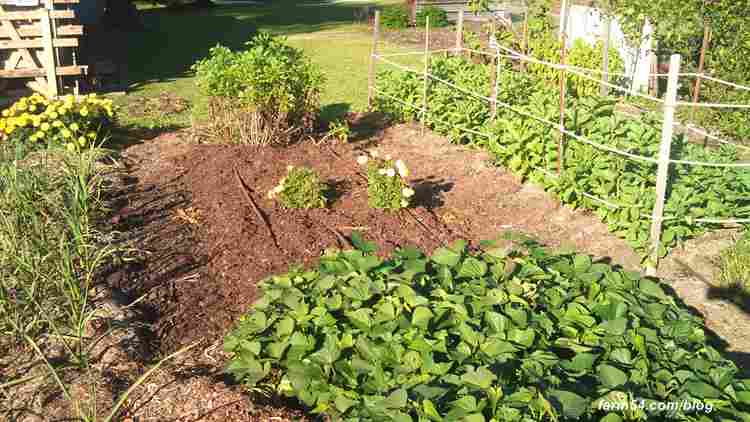
Dripper Lines make garden watering systems practical
Most people, when they go to the big box hardware store look at the irrigation section and get all stressed about buying the pipe and the fittings and fitting the little spray thingies into the pipe. There is none of that. Instead we use the dripper line, where the holes are already in the pipe and the water drips out, usually at a set rate of 2 litres per minute.
Get the drip rate and do some sums
The first thing to do is to attach a hose to the tap and fill a 10 litre bucket and time how long it takes. In my case it takes 20 seconds. From that we work out the tap flow rate.
10 litres in 20 seconds equals 30 litres in a minute, multiply by 60 minutes (1 hr) and we have a flow of 1800 litres per hour from the tap.
This 1800 litres per hour means that I can work out how many metres of dripper line I can run so that the drip rate is 2 litres per hour from all dripper holes. The dripper line I use has 3 drippers per metre. So if I divide the 1800 by 6, I can run 300 metres of dripper line.

Calculator for dripper lines
Still with me. To make it easier, I have devised a little spreadsheet to work it out. All you need to do is put in the numbers and it will tell you how many metres of dripper line you can run from the tap. The reason I put the tap in is that you will most likely run a hose to the garden and clip it into your dripper system. I haven’t got around to digging a trench for a pipe to the garden yet.
To down load the spreadsheet, go here and enter your email address. You will also receive an email when I have made a new post.
Putting your garden watering system together

Diagram of the garden watering system layout
I use a 19mm black poly pipe for the header of my system. The header is where the dripper line is connected to. I have inserted a tap at a lot of the dripper lines, but so far haven’t needed to adjust the watering for various crops.
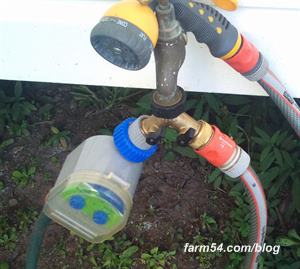
Watering timers are simple, robust and easy to use
To automate the process a timer is required. They are so cheap these days and reliable that every garden should have one. The one you see pictured is simple to operate, can be programmed to water daily, twice daily or monthly. The combinations are endless and easy to work out. I runs on a couple of batteries that have been there for over 12 months. If it is raining, I just turn the water off. The timer keeps opening and closing the valve to the presest times, but no water goes through.
I put a splitter on the tap. After getting two cheap ones that leaked, I finally purchased a good brass one that hasn’t been a problem so far.
Hose Connection to garden watering system

Hose connected to header pipe
A hose runs from the timer to the header pipe of the watering system. The header pipe is 19mm diameter and the dripper lines are 12mm diameter. If I get around to putting a line underground to the watering system I will make that 19mm as well. I have extended my watering system to another bed. The tap has enough water flow to water both garden beds.

By adding taps you can reduce water to areas
To connect the dripper lines to theheader pipe, cut the header pipe at the dripper line position, insert a 19mm T piece with a 12mm T outlet and push the dripper line onto the 12mm outlet. If you want to place a tap in the line add a 50mm piece of 12mm pipe with the tap attached.
Placing mulch on top of the dripper line is a benefit as it stops evaporation. It doesn’t harm the dripper lines.
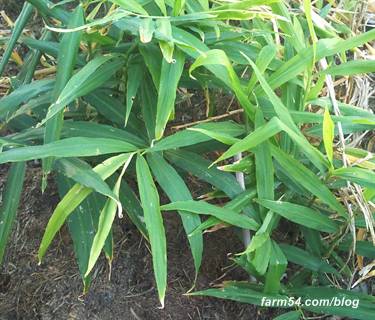
Natural Gardening

The leaves start to yellow as ginger gets close to harvest
A Sub-tropical climate is perfect for growing ginger. Brisbane in Australia is ideal. From my experience with ginger it is a very easy crop to grow and doesn’t take much maintenance.
I started by planting some ginger from the supermarket. I made sure that it was Australian ginger as this would help prevent introducing an overseas disease into my backyard.
Growing ginger from thumb sized pieces

Good buds or eyes and firm piece
All I did was pick all the small pieces out of the tray that looked like they had a growing tip or bud or eye. In most cases they looked like they were starting to grow. I handled them to make sure they weren’t soft and mushy as I felt that this indicated they wouldn’t rot in the ground.
When I first started I didn’t have any clue about the best time to plant, length of time before harvest or the best time to harvest. Over the last two years I have learnt a few things and can give you a few guidelines for growing ginger.
- Best time to plant – early spring
- Best time to harvest – when the leaves have died down Autumn/Winter
- Best growing environment – fertile soil, compost, moisture but not waterlogged, humid tropical environment. Some say partial shade is required, but I have found that ginger can be grown in full sun. I have dripper line irrigation on a timer so that the soil is kept moist. Perhaps this allows the ginger to grow in full sun.

The best part of growing ginger, besides eating is harvesting
I have just harvested some ginger and replanted some of the rhizomes in a new location. This location only gets sun in the morning, so it will be interesting to see if the ginger grows better or worse than in full sun.
There is still quite a bit of ginger to harvest and seeing as the leaves are still mostly green I will leave it a while longer before digging further.
In the top picture some of the leaves are greener than the others. The drier yellowy leaves are from the ginger left in the ground from last year. As mentioned I knew nothing about ginger when I first planted it. I harvested most of the ginger and left the rest in the ground to grow again the following year. It has definitely regrown as you can see from what I have harvested so far.
Leaves still green

Leaves of the small pieces planted are still green
The leaves that are still green are from ginger planted from the bits from the supermarket. On a number of occasions through the year I purchased some small corms and just put them in the soil. The results surprised me as most of them grew. I now have a rather large stock of ginger that I will replant in new locations.
Growing ginger is satisfying and easy to do. If you have a small area, even in the flower garden, bury some corms with the bud side up and be surprised at what you harvest. The leaves look good too and make a great background to more colourful plants.
Replanting a piece of ginger

From the left: Thumbsize piece of ginger, Choose location, Plant ginger eyes up, Cover ginger lightly, Mark the spot. Leave it alone for at least 8 months. It’s that easy

Experiments, Natural Gardening
I like growing Soy Beans. Don’t ask me why as I have no real reason to. I think it stems from my days on a sugar cane farm where we grew it as a soil conditioning crop which made the cane grow gang busters when planted after soybeans.

A few more weeks needed for the soy beans to dry to the right moisture content
I grow them in any new gardening bed as the first crop. This year I had a new bed that I made by solarising the weeds with black plastic for 12 months and then covering with a layer of big cardboard boxes I had been collection and then covering with 30cm of compost. I also threw in some crusher dust and lime. Soy beans love lime.

Final drying after harvesting
To harvest them I cut them off at ground level, leaving the root system in the ground. Hopefully the rhizobia nitrogen fixing bacteria will survive in the root nodules until another crop they like is growing. Now I have to find a use for the beans.
My answer to a use for the soy beans is soy milk. Another use is green soy beans as an entree, see this link for eating green soy beans Soy Beans and Nitrogen Fixing Bacteria
Where to get Soy beans, if you don’t grow your own

Available at Asian Supermarkets
If you don’t want to grow your own soy beans, you can buy them at Asian grocery stores. They are not expensive, around $4 for 1 kilo. The soy beans that you use are white or cream in colour and you only need a cup full to make around 1.5 litres
Traditional Taiwanese method for making soy milk
You will need a blender, a big pot, soy beans, a deep bowl, a stirring spoon and a muslin or filter bag.
Place the beans in the deep bowl, cover with water and soak the beans for 6 – 8 hours.
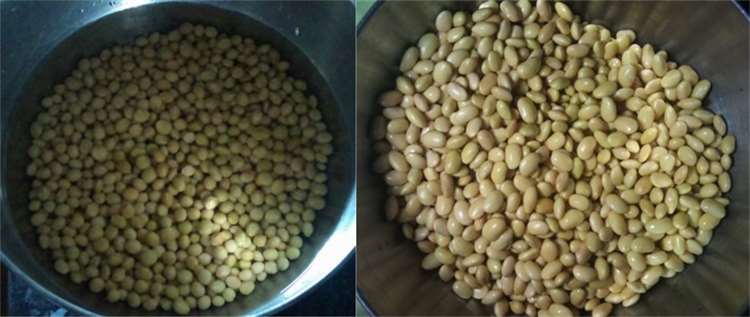
Soy beans with water covering ready for 8 hours soaking and after soaking
How to know when your beans are ready for making soy milk
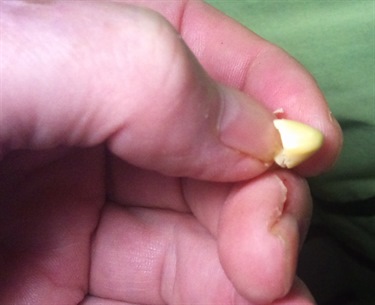
These beans are ready for making soy milk
To test whether your beans have soaked long enough, dig into one with a finger or thumb nail. If you can split it, your beans are ready for the bender.
The beans expand to nearly double the size after soaking.
Add equal quantities of beans and water to the blender and run it for a couple of minutes.
If the blender seems to have trouble moving the paste, stop the blender and add some more water and stir it up with a spoon. Blend again and then strain into the big pot. Place the pulp back into the blender and add the same initial amount of water and reblend.
Bring the strained soy milk to the boil slowly, stirring constantly so that you don’t burn the milk. A big pot is helpful here, because like cow’s milk, it will foam when about to boil and expand to overflow a small pot.
Once it has boiled, turn the heat down and simmer for 30 minutes. Again you need to stir it so that it doesn’t burn.
After 30 minutes remove the heat, add some sugar if you need it, or stevia if you have it, or try some honey. We started with 2 small cups of beans and ended with 1.8 litres of soy milk. If you have ever been to a Taiwanese breakfast shop and tasted their soy milk you will probably agree that the taste is completely different to the cardboard flavoured product you purchase in supermarkets.

Wicking Beds
I finally got off my dot and started the wicking bed construction. The first order of the day was to complete the second coat of exterior paint.

Second coat of paint finished
I got motivated and moved the sleepers onto the pad and gave them all a second coat of exterior paint. Moving them wasn’t my smartest move as I had to move them all off to start construction. Talk about double handling.
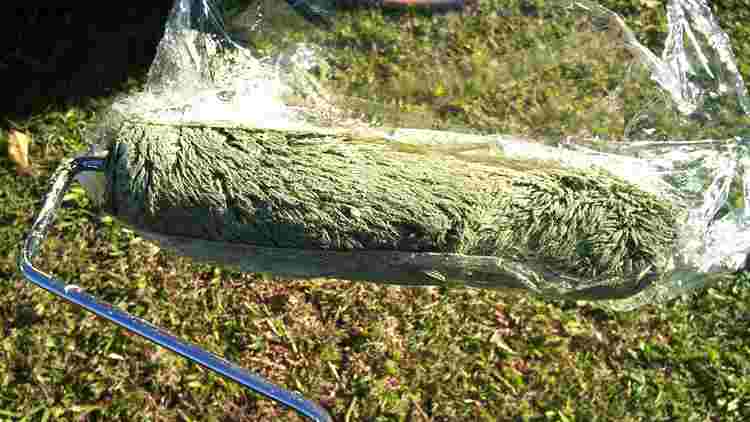
Same paint roller
The first coat of paint was applied on March 28 and the second coat on May 8. The roller was wrapped in cling wrap for that time. I peeled off the cling wrap and used the same roller.

Late in the day
I put in a few hours the next day on the wicking bed construction and nearly forgot to take a photo. This one was late in the day.
Some time spent thinking led to a few changes

Some changes were made to the plan
Quite a few changes were made during the wicking bed construction. I had actually drawn up a plan before I started, but as I progressed I saw some ways to change it that I thought would be for the better.
First, I changed from having the sleepers all join at the same place to having them in a brick pattern. That meant I had to cut one sleeper in the second row in half. I felt that this would make the construction a little stronger as the bed is just sitting on the ground. None of the uprights are sunk into the ground. The brick pattern wouldn’t be seen as all the joins are covered on the outside with an upright, and once the bed is filled with soil and compost you won’t see them on the inside.
Second change quite an improvement.
Originally, my plan was for three layers of sleepers making the bed 60cm high (2ft). After thinking about this for quite a while, I decided that a depth of 45cm would be sufficient as the bed was going to be used mainly for Asian vegetables and quick growing plants with shallow root systems.
By removing the top row I decided to put on a 15cm wide top cap that could be sat on. Nothing better than sitting down doing the gardening. A 15cm seat is much more comfortable than a 5cm wide seat. The top cap increased the height by 5cm.
There is also going to be a frame built over the bed for shade cloth. The shade cloth will serve a dual purpose of insect exclusion and wind protection. It will help keep the plants cooler in summer as well.

Natural Gardening
I have learnt a number of useful hints and growing tips for garlic. This has been over the last two years and trying four different garlic varieties.
- Garlic is a colder weather crop.
- Plant it from the Autumn equinox (22 March in the southern hemisphere) through to early Spring
- The warmer the climate the earlier you can plant.
- There are different varieties of garlic suitable for colder areas and warmer areas
- Saving your best garlic bulbs for replanting improves your results over time. You develop your garlic to be acclimatised to your area.
- Cloves of garlic from the same bulb can take anywhere from four days to 2 months to sprout, even if planted on the same day.

Although this Elephant Garlic clove was planted at the same time as the others it took 4 weeks longer to sprout
I purchase 5 cloves of elephant garlic, three took about 17 days to sprout, another appeared about 24 days after planting and this one just appeared, 48 days after planting.

Two cloves of Silverskin Garlic finally poked through after 48 days
Winterising Garlic (maybe suitable for garlic growing hints and tips)
There are a lot of claims that in warmer locations, if you put your garlic in the fridge for 4 – 6 weeks before planting it will improve the quality of your garlic. I have still to find out if this “winterising” of the garlic before planting is of benefit or not.
Next year, I will winterise half of a bulb and store the other half normally. I hang it in the shed in a hessian bag. When I plant I will mark them and see how the harvest goes.
There are other posts on garlic Garlic Update and Planting Garlic – Four Varieties
If you have any garlic growing hints and tips, help me out and add them in the comments.























